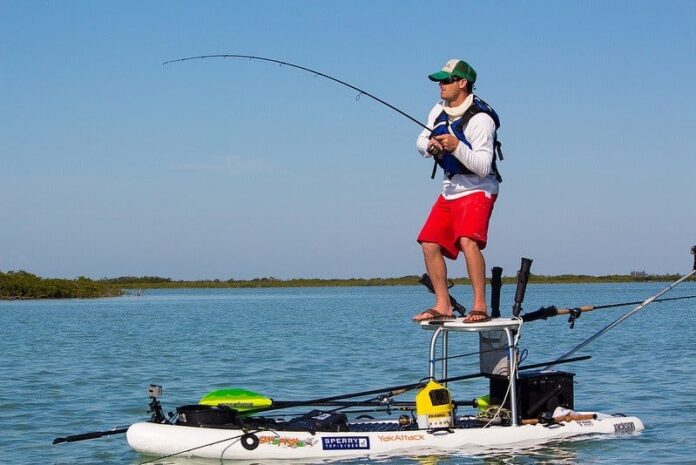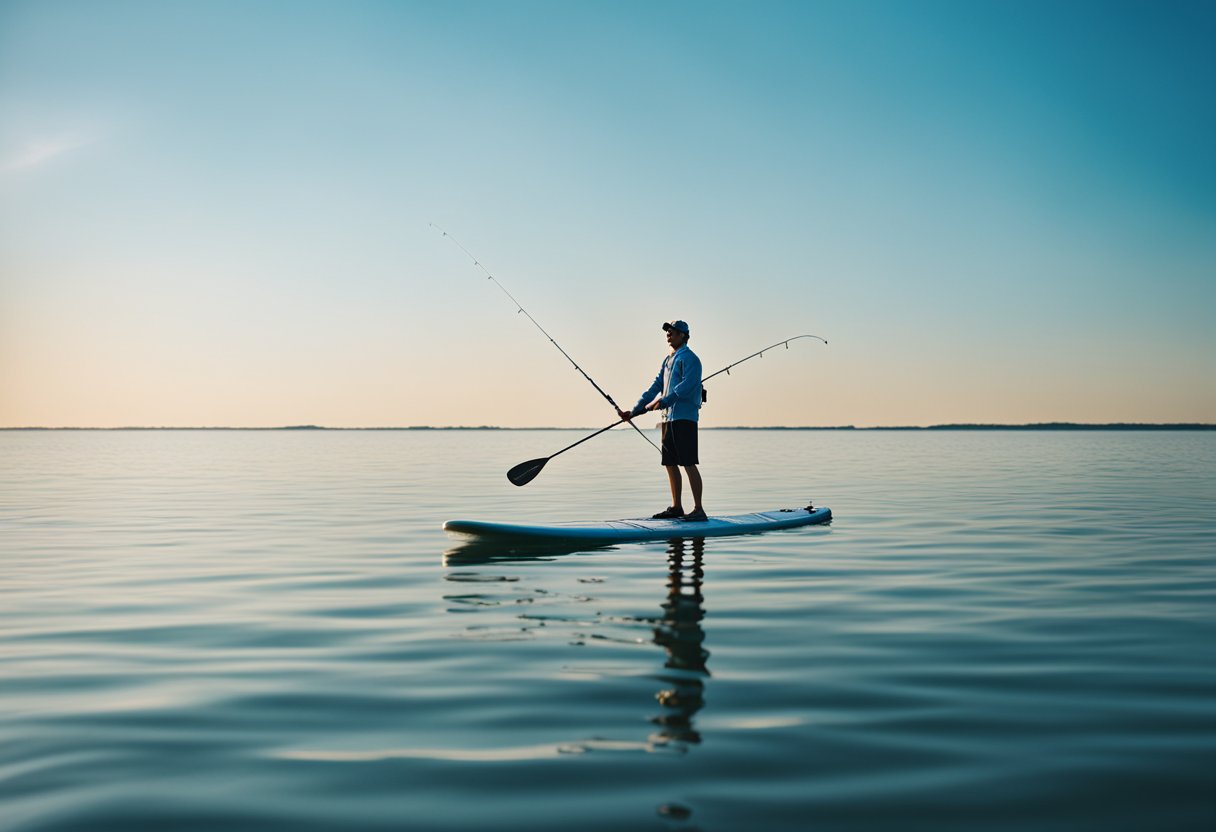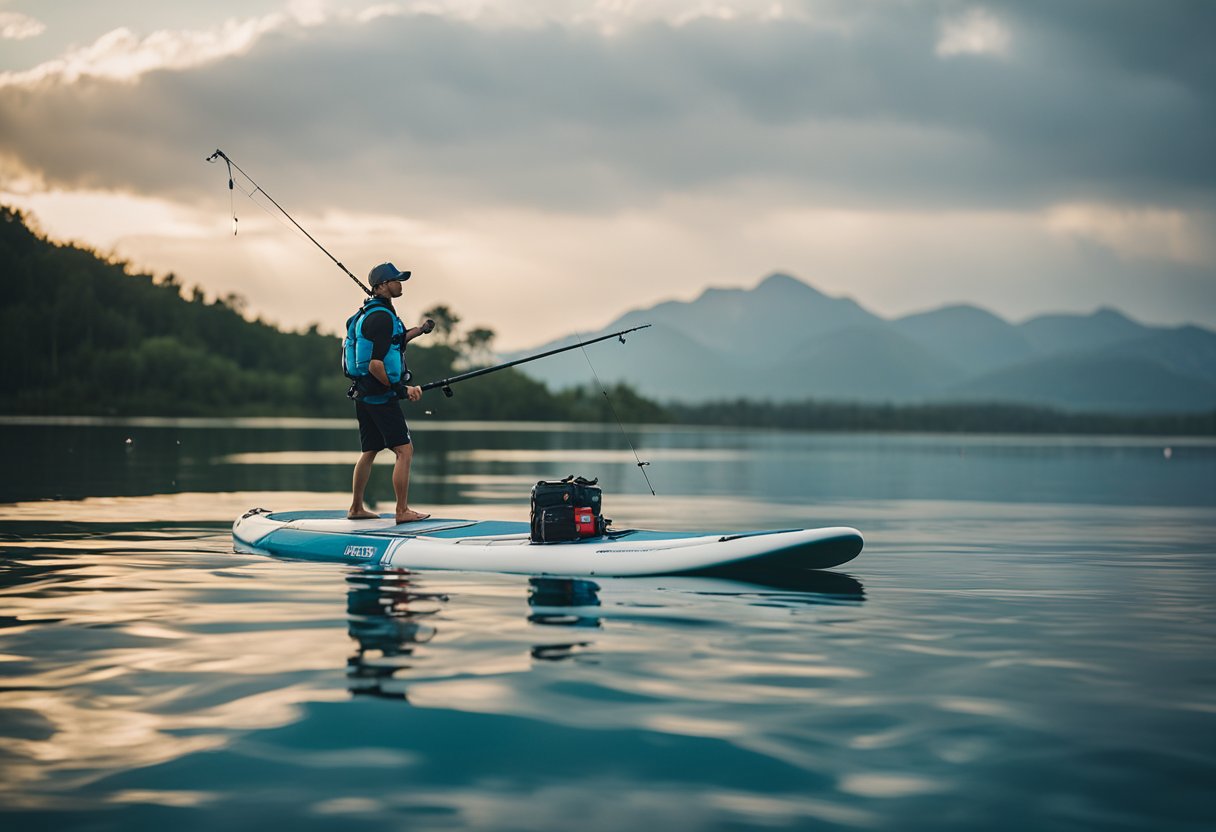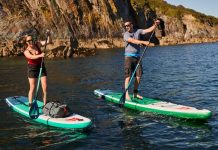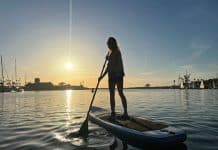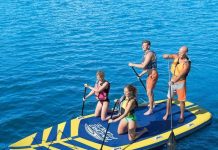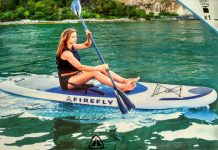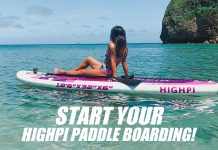Fishing on a paddle board is an exciting and unique experience that combines the thrill of fishing with the serenity of being out on the water. As someone who has been paddle board fishing for years, I can attest to the fact that it is an enjoyable and rewarding activity that anyone can try. In this article, I will share my knowledge and expertise on how to fish on a paddle board, including the gear you need, the techniques you should use, and the challenges you may encounter.
Paddle board fishing, also known as SUP fishing, is a rapidly growing sport that offers a new way to fish. It provides an excellent workout for your core and upper body while giving you access to remote and hard-to-reach fishing spots.
However, it requires some specialized gear and techniques that you should be aware of before you get started. With the right equipment and knowledge, you can have a safe and enjoyable experience while catching fish from your paddle board.
In this article, I will cover everything you need to know to get started with paddle board fishing, including the gear you need, the techniques you should use, and the challenges you may encounter.
Whether you are a seasoned angler or a beginner, this guide will provide you with all the information you need to have a successful and enjoyable paddle board fishing experience. So, let’s dive in and learn how to fish on a paddle board!
Fishing from a SUP is not as difficult as it might seem. If you have been itching to combine two hobbies into 1 – then paddleboard might be for you!
If you have never fished from SUP, you are missing out on another level of fun.
Fishing from a paddleboard lets you sneak into hidden coves quietly, enjoy relaxing, outdoors and provide you the height of benefit to spotting good habits.
Why Fish form a Stand UP Paddleboard?
Why Fish from SUP when I have got a boat with a motor or fishing kayak?
There’re pros and cons of Fishing on a SUP and reasons you want to ditch the motor.
Pros and cons of Fishing on a Paddleboard
A paddleboard is lightweight and more accessible to transport than a boat, and they’re not several boats you can store simply as it hangs on your garage wall.
When fishing from a SUP, you have a height benefit for a more incredible view of the water and fishing habit.
A SUP provides you wide open freedom and space to cast your line and store your gear. You’re not confined by the kayak’s cockpit and can stretch your legs. You will spot the Fish with polarized sunglasses before they take your bait.
You get remarkable experience and fresh air, and you can quality slip into your favorite hole unnoticed without a noisy motor alerting the Fish to your presence.
The bottom line is that Fishing on SUP is much fun.
Paddle Board Fishing Setup
I try to keep my paddleboard as uncluttered as possible, taking all I need for the day. So, here’s a list of what I take:
- 2 rods
- Milk Crate (with 2-rod holders attached)
- Small cooler
- Small tackle box
I take these extras, standard gear, leash, paddle, phone, and life jacket. I attach my milk crate to utilizing the front die-downs. I use a bungee to secure the rod holders to the trunk.
I keep my life vest and tackle box (I also wear a tackle belt with the most-used essentials). I connect my cooler to using bungee and the rear tie-downs.
Typically, I only take a small six-pack cooler with drinks and snacks. Occasionally, though, I’ll take a large cooler that can double as a seat.
Read Next – Inflatable Paddle Board Hippocamp Fishing ISUP
SUP Fishing Tips
If it’s your 1st time trying out this activity, below are the best tips to follow to make your paddleboard fishing experience more convenient and productive.
Watch the elements
The flow, breeze, and tides will significantly impact your anglings experience since SUPs are not heavy.
Before you get out go fishing o a paddleboard, bear in mind to check the weather, wind direction, current, and tied down to ensure they would not stand in your way of paddleboard fishing.
Read Next – Sea Eagle FishSUP 126 Inflatable FishSUP
Look for a license
One must get allowed to fish since different areas might have strict rules, and you’ll even need to receive a special permit for a specific type of Fish.
Carry out some research and never forget to get the vital documents. The fines for unlicensed angling are generally steep, and they’ll leave your financial balance truly gouged.
Bring only what you need.
A fishing SUP has constrained space, and it can’t hold much weight. It’s alright to be energized initially, and you might need to bring all. But having excess gear on that small vessel will put a limit on how quickly you can move on the water.
It’ll slow you down and make the trip to your right fishing area unnecessarily long. Moreover, you might end up losing a fantastic deal of apparatus, some of which might be expensive.
Bring only the needed gears, like obviously, your tackle sack and angling rod. If you notice that you’ve no room to move around, it is probably because you have brought too much for the adventure.
Read Next – Elkton Outdoors Grebe Foot Fishing SUP
Have a clear plan
If this is your 1st-time paddleboard angling, make the Fishing short. Be aware of where you’re going to fish, how to arrive there, and how to get out. The water flow is erratic, so you’d always be prepared for accidents even if you’re an experienced paddler.
Take your time to understand and acclimate yourself with a fishing SUP. A SUP is not equivalent to a vessel, as you’ll come to figure it out. So it needs skills to paddle and Fish fish.
Changing over Stand up paddleboard for angling is very simple. For your 1st day, carry the essentials apparatus, and afterward, you can learn what else you want as you become more understanding with the activity.
Make sure you pick the right paddle board for Fishing that best suits you, and do not be in a rush. Apply the tips mentioned above to have a wonderful time for convenience and safety.
There are many advantages of paddle boarding you mightn’t know, and standup paddleboard fishing is just one way to use a paddleboard. If possible, it is always suggested you try other SUP activities also.
Before starting, note that an ideal fishing SUP would make the experience more enjoyable. So, remember to get your paddleboard from a reliable brand to have the best experience possible.
Read Next – California Board Company Angler Fishing Stand UP paddleboard
Choosing the Right Paddle Board
When it comes to fishing on a paddle board, choosing the right paddle board is crucial. There are a few factors to consider when selecting a paddle board for fishing. In this section, I will cover the types of paddle boards for fishing, stability, space, and the difference between inflatable and solid paddle boards.
Types of Paddle Boards for Fishing
There are different types of paddle boards that are suitable for fishing. Some of the popular types are all-around paddle boards, touring paddle boards, and fishing-specific paddle boards. All-around paddle boards are versatile and can be used for different activities, including fishing. Touring paddle boards are designed for long-distance paddling and have a pointed nose for better speed and efficiency. Fishing-specific paddle boards have features such as rod holders, cooler tie-downs, and ample deck space for fishing gear.
Considering Stability and Space
Stability is an important factor to consider when selecting a paddle board for fishing. A stable paddle board will make it easier to cast and reel in fish. The width of the paddle board is an indicator of stability. A wider paddle board will be more stable than a narrower one. Space is another important factor to consider. Fishing requires a lot of gear, and a paddle board with ample deck space will make it easier to store and access gear.
Inflatable vs. Solid Paddle Boards
Inflatable paddle boards (SUPs) and solid paddle boards are the two main types of paddle boards available. Inflatable SUPs are convenient for storage and transportation, while solid paddle boards are more rigid and offer better performance. When it comes to fishing, solid paddle boards are recommended as they are more stable and can handle more weight. However, if storage and transportation are a concern, inflatable SUPs can be a good option.
In conclusion, choosing the right paddle board for fishing is crucial. Consider the type of paddle board, stability, space, and whether to choose an inflatable or solid paddle board. A paddle board that is stable, spacious, and suits your needs will make your fishing experience more enjoyable.
Essential Gear for Paddle Board Fishing
When it comes to paddle board fishing, having the right gear can make all the difference. Here are some essential items to consider before hitting the water.
Selecting a Fishing Rod and Reel
Choosing the right fishing rod and reel can be a daunting task, but it’s important to find a setup that works for you. Consider the type of fish you’ll be targeting, as well as the size and weight of your paddle board. A shorter, lighter rod may be better suited for smaller fish, while a longer, heavier rod may be necessary for larger species.
When it comes to reels, there are two main types: spinning and baitcasting. Spinning reels are generally easier to use and are a good choice for beginners, while baitcasting reels offer more control and precision for experienced anglers.
Storage and Tackle Solutions
One of the biggest challenges of paddle board fishing is figuring out where to store all your gear. A good tackle box or bag is essential for keeping your lures, hooks, and other accessories organized and easily accessible.
Consider adding rod holders to your paddle board for hands-free storage while you paddle or cast. You may also want to invest in a cooler or dry bag to keep your catch fresh and your snacks and drinks cold.
Safety and Personal Flotation Devices
Safety should always be a top priority when paddle board fishing. Be sure to wear a personal flotation device (PFD) or life jacket at all times while on the water.
Choose a PFD that is comfortable and fits properly, and consider investing in a model specifically designed for paddle sports. In addition to a PFD, it’s also a good idea to carry a whistle or other signaling device in case of emergency.
By selecting the right gear, you can make your paddle board fishing experience both safe and enjoyable.
Setting Up Your Paddle Board for Fishing
Fishing on a paddle board is an exciting and unique way to enjoy the water. However, before you head out, you need to ensure that your paddle board is set up for fishing. Here are some tips to help you get started.
Mounting Rod Holders and Attachments
One of the first things you need to do is to mount rod holders and attachments on your paddle board. This will provide you with a place to store your fishing rods and other equipment. You can install rod holders using screws or adhesive pads. Make sure that the rod holders are securely attached to your paddle board to prevent them from coming loose while you are fishing.
Organizing Your Storage Space
Organizing your storage space is essential when fishing on a paddle board. You want to make sure that everything is easily accessible and that you have enough space to store all of your equipment. Consider using a storage crate or bag to keep your gear organized. You can also use bungee cords to secure larger items such as coolers or tackle boxes to your paddle board.
Anchor Systems for SUP Fishing
An anchor system is essential when fishing on a paddle board. It will keep you in one spot, allowing you to focus on catching fish. There are several anchor systems available for paddle boards, including sand and stake anchors. You can also use a leash to keep your paddle board from drifting away from your fishing spot.
When setting up your paddle board for fishing, it is important to keep in mind the type of fish you are targeting and the conditions you will be fishing in. By following these tips, you can ensure that your paddle board is set up for a successful and enjoyable fishing trip.
Techniques for Paddle Board Fishing
As an avid paddle board fisherman, I have spent countless hours honing my skills and perfecting my techniques. In this section, I will share some of my tips and tricks for successful paddle board fishing.
Casting and Reeling from a SUP
Casting and reeling from a paddle board can be a bit tricky at first, but with practice, it becomes second nature. One important tip is to always cast into the wind. This will help prevent your line from getting tangled in the board or blowing back into your face.
When reeling in your catch, it’s important to maintain a steady balance on the board. Keep your feet shoulder-width apart and your knees slightly bent. This will help you maintain your balance and prevent you from falling off the board.
Maintaining Balance While Fishing
Maintaining balance while fishing on a paddle board is crucial. One important tip is to always keep your weight centered over the board. This will help prevent the board from tipping over and keep you stable while you fish.
Another important tip is to use your paddle as a stabilizer. You can place the paddle across the board and use it to balance yourself while you cast and reel in your catch.
Navigating Different Water Conditions
Different water conditions can pose different challenges for paddle board fishing. In calm waters, it’s easier to maintain your balance and cast your line. However, in choppy waters, it’s important to adjust your technique and be extra careful.
When fishing in current, it’s important to cast your line upstream and let it drift naturally downstream. This will help prevent your line from getting tangled in the current and make it easier to reel in your catch.
By following these tips and techniques, you’ll be well on your way to becoming a successful paddle board fisherman. Remember to practice, stay safe, and have fun out on the water!
Practical Tips for a Successful Fishing Trip
As an avid paddle board fisherman, I have learned a few practical tips that can help make your next fishing trip a success. Here are some things to keep in mind:
Dealing with Weather and Wind
When planning your paddle board fishing trip, it’s important to check the weather and wind conditions. Wind can make it difficult to paddle and steer your SUP, and can also affect the way fish behave. I recommend checking the weather forecast and wind direction before heading out, and planning your route accordingly. If the wind is too strong, it might be best to reschedule your trip for another day.
Transporting and Launching Your SUP
Transporting your SUP to the lake or river can be a bit of a challenge, but with a few simple tips, it can be a breeze. First, make sure your SUP is properly secured to your vehicle. Use a roof rack or tie-down straps to keep it in place. When you arrive at the launch site, take your time to carefully unload your SUP and gear. Make sure you have everything you need before launching, including your paddle, life jacket, fishing gear, and any snacks or drinks.
Fishing Etiquette and Conservation
When paddle board fishing, it’s important to follow proper fishing etiquette and conservation practices. Always be respectful of other fishermen and boaters on the water, and avoid getting too close to other people’s fishing spots. If you catch a fish, handle it gently and release it quickly if you don’t plan on keeping it. Make sure to properly dispose of any fishing line or other debris, and avoid disturbing the natural habitat of the fish and other wildlife.
By keeping these practical tips in mind, you can have a safe and successful paddle board fishing trip. Remember to always be prepared, respect the environment, and have fun!
Additional Accessories and Considerations
When it comes to fishing on a paddle board, having the right accessories can make all the difference. In this section, I will cover some additional accessories and considerations that will help you have a successful and enjoyable fishing experience.
Choosing the Right Lures and Bait
Choosing the right lures and bait can be the key to catching fish. Consider the type of fish you are targeting and the conditions you will be fishing in. Some popular lures for paddle board fishing include topwater lures, crankbaits, and soft plastics. Live bait such as worms, minnows, and shrimp can also be effective.
Protective Gear and Clothing
When fishing on a paddle board, it’s important to protect yourself from the sun, wind, and water. Wear a hat to protect your face and head from the sun, and consider wearing polarized sunglasses to reduce glare and improve visibility. Dress in layers to stay comfortable in changing weather conditions, and wear quick-drying clothing to stay dry. Don’t forget to apply sunscreen and bring a dry bag to keep your belongings safe and dry.
Maintenance and Care for Your Gear
Taking care of your gear is important to ensure it lasts and performs well. After each use, rinse your paddle board, paddle, and fishing gear with fresh water to remove any salt or debris. Store your gear in a dry and cool place, and avoid exposing it to direct sunlight for extended periods of time. Check your gear regularly for any signs of wear or damage, and replace any worn or damaged gear as needed.
By considering these additional accessories and considerations, you can enhance your paddle board fishing experience and increase your chances of catching fish. Remember to always prioritize safety and take care of your gear to ensure many successful fishing trips to come.
Advanced Techniques and Strategies
Targeting Specific Fish Species
When fishing on a paddle board, it’s important to have a strategy in place for targeting specific fish species. Different types of fish require different techniques and bait. For example, if you’re targeting bass, you may want to use a topwater lure or a weedless jig. If you’re targeting catfish, you may want to use live bait or cut bait.
To increase your chances of catching a specific type of fish, research the fish’s behavior and habitat. Look for areas where the fish are likely to be feeding or hiding, such as near structure or in shallow water.
Stealth and Approach in Shallow Waters
When fishing in shallow waters, it’s important to be stealthy and approach the area carefully. Paddle quietly to avoid spooking the fish, and try to approach the area from upwind or up-current. Use a polarized pair of sunglasses to help you spot fish in the water.
When you’re ready to cast, make a soft, accurate cast to avoid splashing the water and scaring off the fish. Consider using a longer rod to help you make longer casts and keep your distance from the fish.
Fighting and Landing Your Catch
Once you’ve hooked a fish, it’s important to fight and land the fish carefully to avoid losing it. Keep your rod tip up and use a smooth, steady motion to reel in the fish. If the fish starts to pull hard, let it run and tire itself out before reeling it in again.
When you’re ready to land the fish, use a net or your hands to carefully lift the fish out of the water. Be gentle and avoid squeezing the fish too tightly, as this can harm the fish and decrease its chances of survival after release.
Remember, fishing on a paddle board requires patience, skill, and attention to detail. By using the right techniques and strategies, you can increase your chances of catching a variety of fish species in shallow waters.
Frequently Asked Questions
What equipment do I need to start fishing from a paddle board?
To start fishing from a paddle board, you will need a few essential items. First, you need a stable and durable paddle board that is specifically designed for fishing. You can also use a regular SUP for fishing, but it may not be as stable or have the same features as a dedicated fishing paddle board. You will also need a paddle, a personal flotation device (PFD), a fishing rod and reel, a tackle box, and bait. It is also recommended that you bring a cooler to store your catch and any drinks or snacks you may need.
How do I set up my paddle board for fishing?
Setting up your paddle board for fishing involves a few steps. First, you need to attach a fishing rod holder to your board. You can use a clamp-on rod holder or a flush mount rod holder that is permanently attached to your board. Next, you need to attach a leash to your paddle board and your PFD to ensure your safety while fishing. It is also a good idea to attach a waterproof bag or container to your board to store your tackle and other gear.
Can I use a motorized paddle board for fishing, and what are the benefits?
Yes, you can use a motorized paddle board for fishing. A motorized paddle board can help you cover more distance and reach areas that are difficult to access with a traditional paddle board. It can also help you conserve your energy and allow you to focus more on fishing. However, keep in mind that motorized paddle boards may not be allowed in certain areas, so be sure to check local regulations before using one for fishing.
What are the advantages of using an inflatable paddle board for fishing?
Inflatable paddle boards have become increasingly popular among anglers due to their portability and convenience. They are easy to transport and store, and they can be inflated quickly and easily using a pump. Inflatable paddle boards are also more durable than they used to be, and they can handle rougher water conditions. They are also less expensive than traditional hard paddle boards.
How can I securely attach a fishing rod holder to my paddle board?
To securely attach a fishing rod holder to your paddle board, you can use a clamp-on rod holder or a flush mount rod holder. A clamp-on rod holder attaches to the board using a clamp, while a flush mount rod holder is permanently attached to the board. Make sure to choose a rod holder that is compatible with your board and that is made from durable materials.
What techniques should I know for saltwater fishing on a paddle board?
When saltwater fishing on a paddle board, it is important to use the right techniques to ensure your safety and success. Some important techniques to know include anchoring your board to prevent drifting, casting with the wind to improve accuracy, and using lures and baits that are appropriate for the species you are targeting. It is also important to be aware of your surroundings and to avoid areas with strong currents or rough waves.
End words…
Fishing from SUP can be a lot of fun. Just ensure you’ve all of your accessories organized. That way, you can access any lure at any time when needed.
And please, do not forget to follow each of your safety precautions.
Read Next – Aqua Marina Drift Fishing Inflatable Stand-up Paddle Board
Elkton Outdoors Inflatable Fishing Paddle Board Grebe - 12 ft Fishing SUP Package, Fishing Rod Holders, Paddle, Leash, Carry Bag, Pump, Accessory Mounts and Non-Slip EVA Deck
Aqua Plus 10ft6inx33inx6in Inflatable SUP for All Skill Levels Stand Up Paddle Board, Adjustable Paddle,Double Action Pump,ISUP Backpack, Leash, Shoulder Strap,Youth,Adult Inflatable Paddle Board
1 used from $115.62

